“Powder Horns: Fabrication & Decoration” a book review
Jim Stevens is a member of the Honourable Company of Horners and an author. Stevens wrote Powder Horns: Fabrication & Decoration. I asked Stevens if I could review the book and he sent me a loaner copy very quickly. My assessment of the book follows and I hope you enjoy it. By the way, the HCH’s publication, The Horn Book, will have a more detailed article about Jim Stevens in the next issue. Thanks for reading, Rick Sheets HCH Webmaster
 Powder Horns: Fabrication & Decoration
Author: Jim Stevens
Schiffer Publishing
Size: 8 1/2″ x 11″
Illustrations: 275 color photos
Pages: 176
Binding: Soft Cover
First of all, I want to thank Jim Stevens for allowing me to review his book.
The book is thoughtfully laid out in six chapters, from horn basics through how to strap the horn for carrying. You can start with a fresh horn or hull, learn to turn it into a powder horn, embellish it and then finish with a finger woven strap. Stevens’ book does not gloss over anything.
Something I look for in a “how to” book is appropriate illustrations or photographs. Stevens’ book has 275 of them. Stevens’ writing is clear and concise. He picked a clean, modern type face and size that makes the book easy to read.
Chapter 4 was most interesting for me. Stevens takes the reader through the decorating process. Stevens illustrates the time-tested scrimshaw techniques for the purist.
And then how to use technology to help get the image you want on your horn. The option of using modern transfer techniques is very nice if you have a complex image to reproduce or if you are challenged in drawing. So do it old-school or new-school; it is up to you.
I would like to point out that the book has what I consider a bonus; you will find a whole chapter on how to weave a strap using several different methods. Using the clear instructions in this book removes any excuse you have for making a nice horn and then strapping it badly!
After reading Powder Horns: Fabrication & Decoration, I can truthfully say, “Pick-up the book, then buy your horn and tools.” You will save a few false starts and a wasted horn or two.
>>Buy the book from Schiffer Publications from this link.<<
-Rick Sheets
Powder Horns: Fabrication & Decoration
Author: Jim Stevens
Schiffer Publishing
Size: 8 1/2″ x 11″
Illustrations: 275 color photos
Pages: 176
Binding: Soft Cover
First of all, I want to thank Jim Stevens for allowing me to review his book.
The book is thoughtfully laid out in six chapters, from horn basics through how to strap the horn for carrying. You can start with a fresh horn or hull, learn to turn it into a powder horn, embellish it and then finish with a finger woven strap. Stevens’ book does not gloss over anything.
Something I look for in a “how to” book is appropriate illustrations or photographs. Stevens’ book has 275 of them. Stevens’ writing is clear and concise. He picked a clean, modern type face and size that makes the book easy to read.
Chapter 4 was most interesting for me. Stevens takes the reader through the decorating process. Stevens illustrates the time-tested scrimshaw techniques for the purist.
And then how to use technology to help get the image you want on your horn. The option of using modern transfer techniques is very nice if you have a complex image to reproduce or if you are challenged in drawing. So do it old-school or new-school; it is up to you.
I would like to point out that the book has what I consider a bonus; you will find a whole chapter on how to weave a strap using several different methods. Using the clear instructions in this book removes any excuse you have for making a nice horn and then strapping it badly!
After reading Powder Horns: Fabrication & Decoration, I can truthfully say, “Pick-up the book, then buy your horn and tools.” You will save a few false starts and a wasted horn or two.
>>Buy the book from Schiffer Publications from this link.<<
-Rick Sheets
PS: Please note that Jim Stevens will be giving: Scrimshaw Instruction June 6 – June 10, 2011 at The NRA Gunsmithing School Trinidad State Junior College (Trinidad, CO) Follow this link for more information. www.scrimshawstudio.com/tsjc.html
Search for the Ackley Horn
We had an unusual request from Mark Ackley, who is a family historian. He needs help to find an heirloom that was sold at auction. The details of the powder horn in question are sketchy and the only known photographs of the horn are not the best. What we can see is a nice, right side horn with a cityscape engraving at the top. The horn has little twist and the low dome butt is held with domed tacks. There is additional engraving on the horn, but one cannot tell much from the photos. If you know the whereabouts of this horn, please use the form below. Regards, Rick Sheets HCH Webmaster
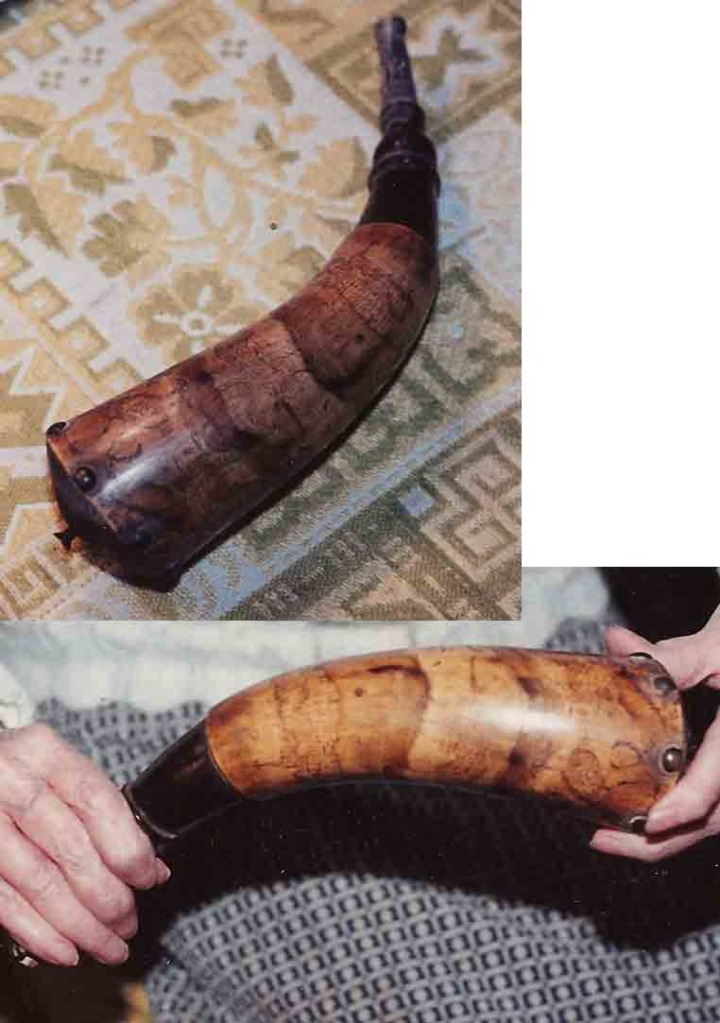
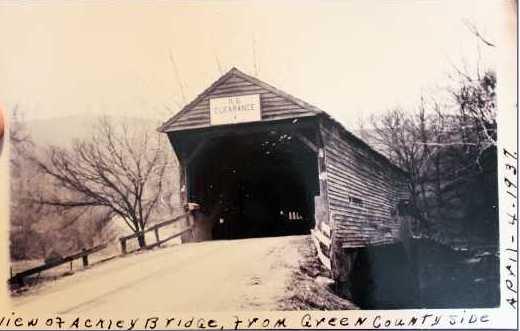 If you know where this horn is, please use the form below.
If you know where this horn is, please use the form below.
The Spring Pole Lathe Project – Update March 12, 2011 – Nearing Completion
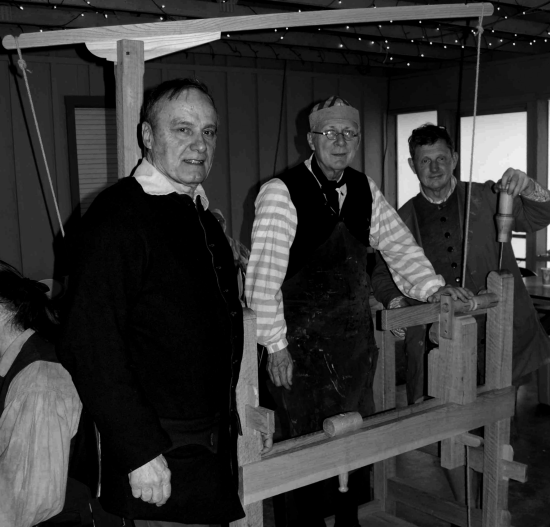
Left to right. Ed Long, Guildmaster, Dick Toone, lathe builder and Rowland Cadle, Master Horner and Founder.
Dick Toone, project leader of the spring pole lathe project, displayed the lathe at the HCH’s Fifteenth Annual Meeting at Fort Roberdeau. It was very close to completion. Once it is complete the lathe will enable the user to turn all of the parts for a screw-tip horn using only human power much the way it was done in the 18th and the early 19th Centuries.
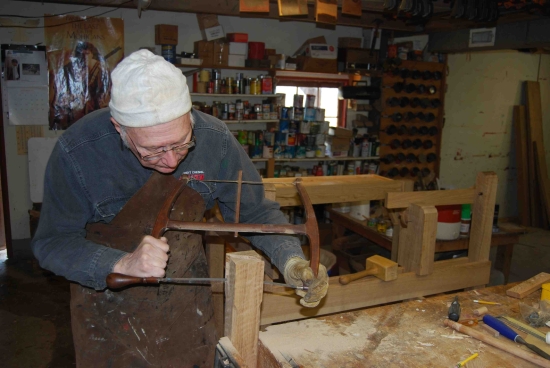
Dick Toone is sawing out the slot for the boom to pivot on with best tool for the job, an original bow saw.
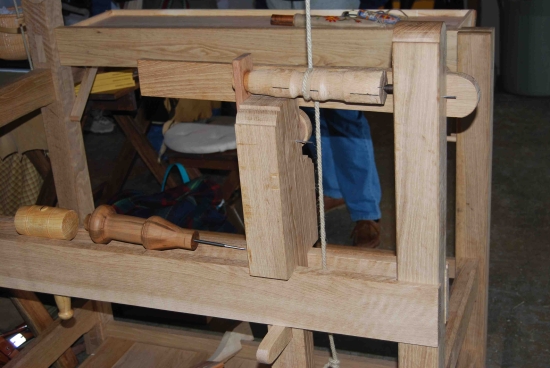
Temporary Mandrel
Here is the the temporary mandrel (with the rope around it) supported on a fixed center point at right and the bearing end in a temporary support of wood. When finished the mandrel will be made with a short piece of octagonal rifle barrel with a brass bearing on the end to the left and a wooden spool where the rope will turn it. The rifle barrel end protruding from the bearing will have coarse external threads that various fixtures (face plates) will thread on to to hold screw tip horn parts for turning. Also shown is a mandrel with a fixed drill bit installed made by Erv Tschanz. Several fixed tool mandrels will be employed to do various functions in the manufacture of a screw tip horn.
The next installment will show the finished Portable 18th Century Spring Pole Lathe.
By the way, I urge you to go to Dick Toone’s website, Living History Shop, to view his museum quality 18th Century reproductions.
Regards, Rick Sheets HCH Webmaster
The Spring Pole Lathe Project – Update Feb. 28, 2011
It is one thing to buy a plan from a trusted source for a gizmo that has been proven to work. It is a whole new ball game to take an idea for a machine and use period building techniques and years of experience to draw-out your own plan. This is what Dick Toone does and then he builds it.
I have asked Mr. Toone to keep us abreast on the Spring Pole Lathe Project. Mr. Toone believes it will be ready to use at Ft. Roberdeau.
Here is a little teaser on some on the building in process in Mr. Toone’s own words.
Thanks Dick for keeping us informed.
Best regards,
Rick Sheets
HCH Webmaster
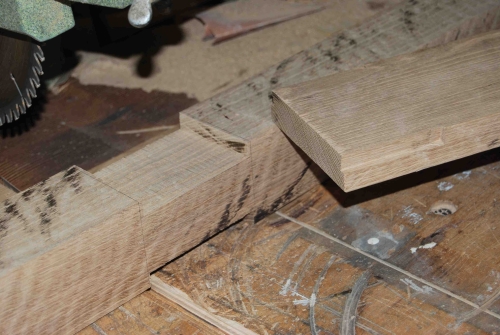
Spring Pole Lathe – White Oak Uprights

Spring Pole Late – Posts
I will send more photos next week.
Dick
Spring Pole Lathe Project Update – We Need Lathe Tools
To ensure a better 18th Century presentation, these tools can all be used (not new) and do not have to match. It would be preferable that not be shiny chrome for the 18th Century theme. The tools will be stored on a special chest to go with the lathe along with other necessary tools and accessories. The supply of the tools will be a way for members to participate in the Lathe project.
Please bring the tools to the 2011 Annual Meeting now being held at Ft. Roberdeau in Altoona, Pennsylvania.
Regards,
Dick Toone
Project Leader
Col. Carl Dumke, USAF an Emerging Horner
Carl Dumke does take on commissions for trade signs on occasion. You may reach him through his email address, which is cdumke99@aol.com.The Jonathan Bagley Horn (by Carl Dumke) Dumke identifies with Col. Bagley and wanted to make a horn to honor Bagley’s engagement against the Iroquois and French at Fort William Henry. Here is a series of photos of a campaign horn in period style inspired by the horner John Bush. (The pictures are lightened to show the detail of the horn.)
The Spring Pole Lathe Project – Update Dec. 2010
I asked the project leader, Dick Toone, for an update on the Horn Guild’s spring pole lathe progress. Dick was kind to supply an answer and some musings as well. “Tip In or Tip Out?” Dick takes on this question…. please read on. And by the way, Dick is no stranger to 18th Century practical objects. See his website at www.livinghistoryshop.com
Best regards,
Rick Sheets

Dick Toone with some of his wares.
My son, Rick, is a luthier and studying 17-18th Century violin makers’ techniques to advance his acoustic guitar knowledge and voiced his opinion that everything in the “pre-modern fastner/manufacturing period” had a reason for use. I agreed and we deserted the kitchen for the gun shop, there being horns to play with.
When I needed a powder horn to use with the first rifle I made in 1977 I, like my buddies chose from a heap of raw horns ones one that fit the contour of my body on the right hand side with the tip snug to the belly. This was the popular thought of the embryonic trekking period and well before Roland Cadle’s espoused observed knowledge. Didn’t want to catch that tip running through the brush! Reinforcing the idea there must be a reason for the shape selection of the powder horn I noted that the professional horn builder in the 18th century would have received an equal amount of left and right horns to work with yet selected the right side for powder horns. Right handedness was considered correct for eons and children were taught to write with their right hand even if they were left handed. My observation in Africa and more recent television exposure of other nations eating procedures of using only fingers of their right hand, enhanced by the knowledge that there is no toilet paper in these areas leads me to believe that there is a deep rooted reason buried back in our physic for aversion to left handedness. In today’s Western Civilization lefties are OK even desired in baseball pitchers.
Rick and I then donned horns with “tip in” and “tip out” and observed each other going through the measuring and loading procedure and compared our thoughts. Shortly, younger son Rob (age 40) stuck his nose up in the gun shop to see if he was missing out on something important like dividing the family fortune (or lack of fortune) and we immediately recruited him into our experiment with no explanation. (Both of our sons grew up with muzzleloaders as their earliest gun experience.)
All of us confirmed that the flow of powder coming out of a “tip out” right side worn horn was easier to control than ‘tip in” – though slightly. Independent of collaboration both boys thought falling flat head first on a “tip-in” horn would hurt more and were a “tip-out” horn to ever be inverted over a muzzle directly and a flash back occur the full weight of the powder in the horn would be exposed to possible spark rather than a slim trail in the neck leading to the main body of powder. We cut off the experimentation in time to get the turkey out of the oven before the ladies found out what we were doing.
Dick Toone
The Hartley Horn Drawings, a book review by Rich Pierce
I asked my friend Rich Pierce to write a review of our new publication as Rich has a unique perspective of the Hartley drawings. Not only is Rich Pierce is a member of the CLA and an amateur gunsmith, horner and accoutrement maker, but a relative of Mr. Hartley himself. Thanks for reading this review. Best regards, Rick SheetsThe Hartley Horn Drawings, Presented by the Honourable Company of Horners
A Book Review by Rich Pierce, guest author
This new book published in 2010 of powder horn illustrations is unique in several ways. It presents drawings made in the 1930’s of early, decorated powder horns from the Mohawk River valley of New York state. Instead of photos of horns, colored drawings of horns are presented as if the “skin” was unwrapped and laid flat so we can visualize the entire horn in one view. These drawings were painstakingly made by Robert M. Hartley, an amateur historian and archeologist, and represent just one aspect of his contributions to area history and material collections.
This 79 page soft cover book, 8 ½” x 11”, in color on glossy paper represents the work of the Honourable Company Horners (HCH), a group of dedicated craftsmen, historians, and collectors. The book begins with a brief history of that organization, background about the Margaret Reaney Memorial Library and its collections in St. Johnsville, NY where the original drawings are displayed, and a chapter about the techniques employed in drawing powder horns as if they were “unwrapped.” Following this interesting background information, we find drawings of forty horns. The whereabouts of only a small number of these horns is still known, so for the most part these horns will be new to the reader’s eyes. In cases where the original horn has been located, photographs of the horn are shown beside the Hartley drawings, offering a real sense of the accuracy of his renditions. The horns illustrated here offer a rather unique view into history through two lenses. First, Mr. Hartley wrote what was known of each horn including some history of its original and current owners at the time of drawing in the 1930’s. Secondly, some drawings are also accompanied by a brief commentary by a Master Horner of the HCH, offering insights about the styling of the horn and its decoration. The drawings feature horns from the French and Indian War period through the War of 1812. Several classical map horns of the French and Indian and Revolutionary Wars are illustrated, some appearing to be professionally made and decorated, and others decorated in folk art styles. Of the important horns included there is a Jacob Gay horn dated 1759; this is his earliest of twenty horns known by his hand. Many of the horns are simply spectacular; tastefully decorated throughout the body with maps, geometric, floral, or military designs, and sketches of animals and persons of the time.
Two of my personal favorites are the Aaron Putnam horn, 1776, and the John I. Putnam horn dated 1757. Hartley was able to link a number of the horns to local soldiers who served in the French and Indian and Revolutionary Wars, providing insights into frontier life in the Mohawk and Schoharie Valleys in New York. Following the presentation of the forty horn drawings there is an analysis of the elements of design found on these horns, cataloguing the use of maps, coats of arms, forts, ships, persons, animals, people, etc, showing the most interesting motifs in higher magnification for our study. I found the book to exceed every expectation, though in retrospect I should not be surprised in the least, for the HCH is a company of extraordinary craftsmen and artists who are gifted in design and dedicated to our history.
The layout and design of the book are of first quality and for those who are fascinated by early powder horns, I consider this a “must have” book that will be perused over and over, offering glimpses into our history and a valuable resource for the horners of today and tomorrow. My interest in the Hartley drawings predates the genesis of this fine book. Robert M. Hartley was my great-uncle; that is, he married my grandfather’s sister, Fannie Pierce. Around 1960, when I was about seven years old, Aunt Fannie passed away and my grandfather was the executor of her estate. I accompanied my grandpa as he sorted through the household goods and accompanying farming equipment at the Hartley estate, which we considered a “mansion.” Robert M. Hartley had lived as a country gentleman-farmer, employing others to do the farm work while he pursued his interests in archeology and history. Among the many items in their attic were some copies of the Hartley drawings now shown in this new book. Though I was just seven or eight years old, these black and white copies of magnificent historical horns captured my imagination. Grandpa said I could have those old papers if I wanted them. I kept the copies of those drawings with me for decades, hauling them from my childhood home in the Mohawk Valley of New York State to New Jersey, then Missouri as we followed our careers.
Around 2005 I was planning another powder horn and looked to my copies of the Hartley drawings for inspiration. I chose what I call “the Ugly Mermaid Horn”, dated 1757, and inscribed with the name, Daniel Weatherhead. Hartley’s drawing of this horn is pictured on page 26 of the new book. In addition to a large figure of a rather unattractive mermaid, this French and Indian War era horn is decorated with floral designs representing seaweed, sea-snakes, and a nice, thick codfish. I took some liberties as I made my own “Ugly Mermaid Horn” including an unplanned but necessary sheet brass repair fastened over a crack with nails and cutlers resin. I learned that John Proud and other members of the Honourable Company of Horners were planning a book about the Hartley drawings, and was delighted to know that Hartley’s drawings would soon be available for enthusiasts.
I am sure these old drawings will help provide new inspiration for many horners, collectors and historians.
-Rich Pierce
Click here to order the book.

A Spring Pole Lathe in the making for The Horn Guild House.
The purpose of the visitation was to gain knowledge from an original lathe so that a similar design could be produced for use in the Horn Guild house next to Jacobsburg Historical Society’s property in Bolton, Pennsylvania. This lathe will be portable and used to reproduce early powder horns with turned elements.
I will undertake the reproduction project and will be assisted by other guild members. The target date for lathe’s completion is March, just in time for the HCH Convention in Morristown, NJ. I want to thank Blake Stevenson and the staff of Old Salem Museum and Gardens for their help with this undertaking.
Old Salem Museum and Gardens is located in Old Salem, North Carolina. Please visit their website by clicking here, www.oldsalem.org.
Regards,
Dick Toone









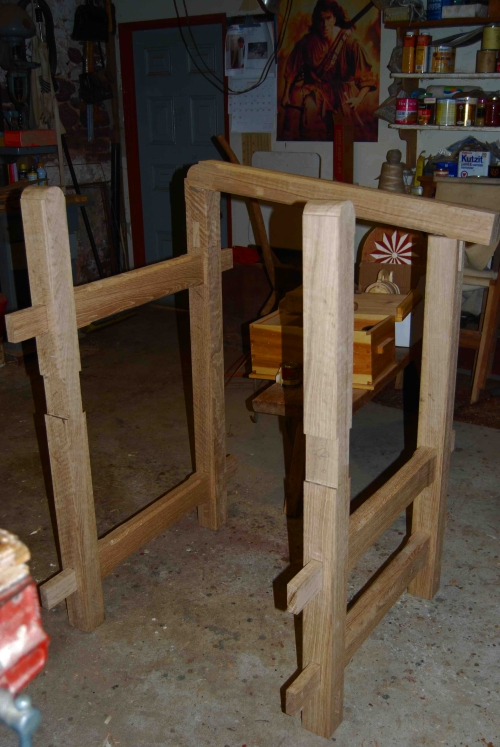
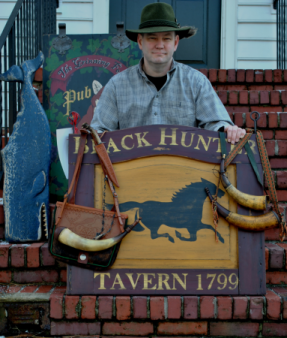
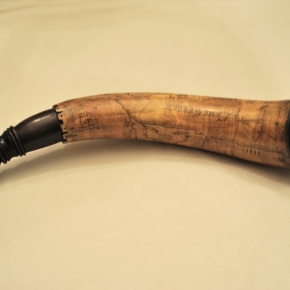
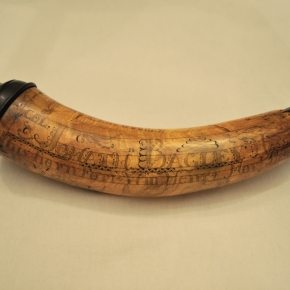
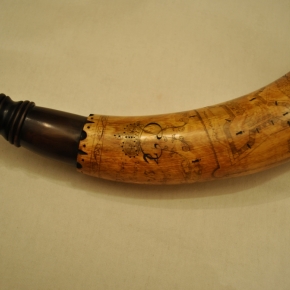

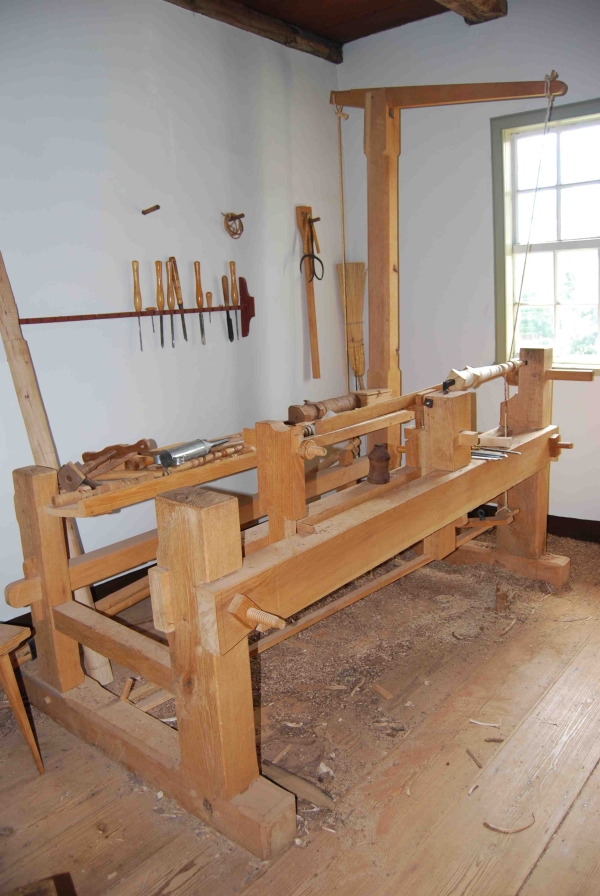
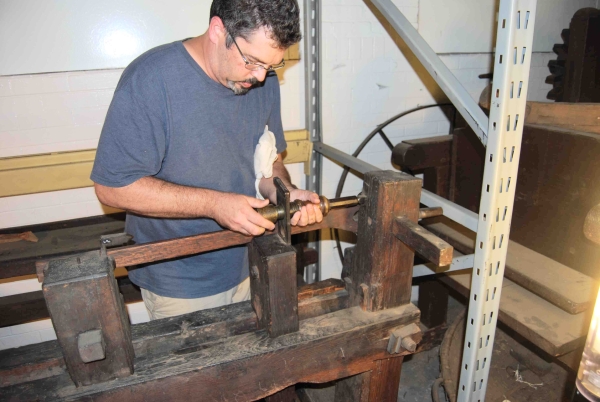
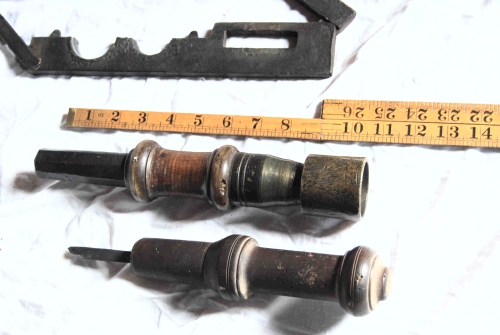
Recent Comments